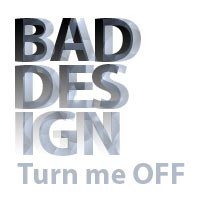Have you ever searched for something on Google, and clicked on a search result based on the page description because it sounded exactly like what you were looking for? Then, when you arrive on the page, you were almost immediately turned off based on the page design or layout, so much so that you hit the back button to try another result?
This has happened to me many, many times, and I’m sad to say that I may have missed out on great content because of the way the blog or website is designed. Here are some design-based reasons I have left a page that promised relevant information.
Pop-up Adverts
Probably one of the most common reasons I have left a web page before I found the content I was seeking is because of those pop-up advertisements that will not go away. I can forgive the simple small ones that want you to join their mailing list, although I think if you are a first time visitor, you should be given time to find out what the site is about before being asked to receive updates for it.
The unforgivable ads are the ones that do not take into consideration visitors on a lower resolution display. Because of their large size and the fact that the ad is fixed in place, I cannot get to the close button, or worse, there is no close button for a certain length of time unless you do sign-up for the offer.
Almost Endless One Page Sales
Another popular design flaw is the almost never-ending one page sales site. Some of these items I’m sure are great deals, and I know the goal is to give me so much great information that by the time I find the price, I will already be sold. But these sales pages need to consider the fact that not everyone wants to scroll through ten lengthy testimonials, the “wait, act now and you’ll also get” additional offers, videos, and what not.
I think these sites would better served if they just stated what the main benefit of the product is, have one video, one testimonial with a link to others, if people are interested, a list of additional items with a short summary and link for additional details, then the price. Because I have left many of these sales pages simply because if the page is that long, the deal is probably not that great. Since these blogger templates are so popular, if I don’t know a little about the product before I hit the page, I leave almost automatically when I see that it is that kind of page.
One sales page I like in particular is the one for the 31 Days to Build a Better Blog. While it is a long page, it isn’t endless, and it gets to the main point – product price and purchase button – early on and often throughout the page, as opposed to having to scroll down to sometimes the bottom or close to the bottom and then searching for what you really want to know. It’s also not just the one page sales ad – it is built into the blog, so you can see that there is a lot more to offer than just that product.
AdSense Blog Themes
You know them. The blog themes that are designed specifically for AdSense. I have nothing against AdSense, because I do use it myself. But I think that you can have a well designed theme and just include the AdSense. Also, there is nothing worse than having to wade through the ads to find the real content. If I can’t spot a navigation system and the first post on the blog because of all of the ads, I typically move on.
Really Old or Standard Templates / Themes
Typical information seekers on the Internet are looking for the most current, relevant content. It is hard to believe on the first impression of a site using a web layout that looks over five years old that it is going to have up to date information. So if you are using a really old theme, or one of the generic ones supplied by your blogging platform, it might be time to update it to something newer.
If you are on WordPress, look up the latest themes by searching Google for WordPress themes and then narrowing your search results to articles that have been written this month. If you are on Blogger / Blogspot, go beyond the basic ones offered through their system and try sites like Blogger Templates. Even blogging sites like Tumblr have more themes than just the standard ones available through their main site.
More Design Faux Pas
When you are perusing content on the web, what design and layout elements deter you from actually getting to, or even caring about the content?
